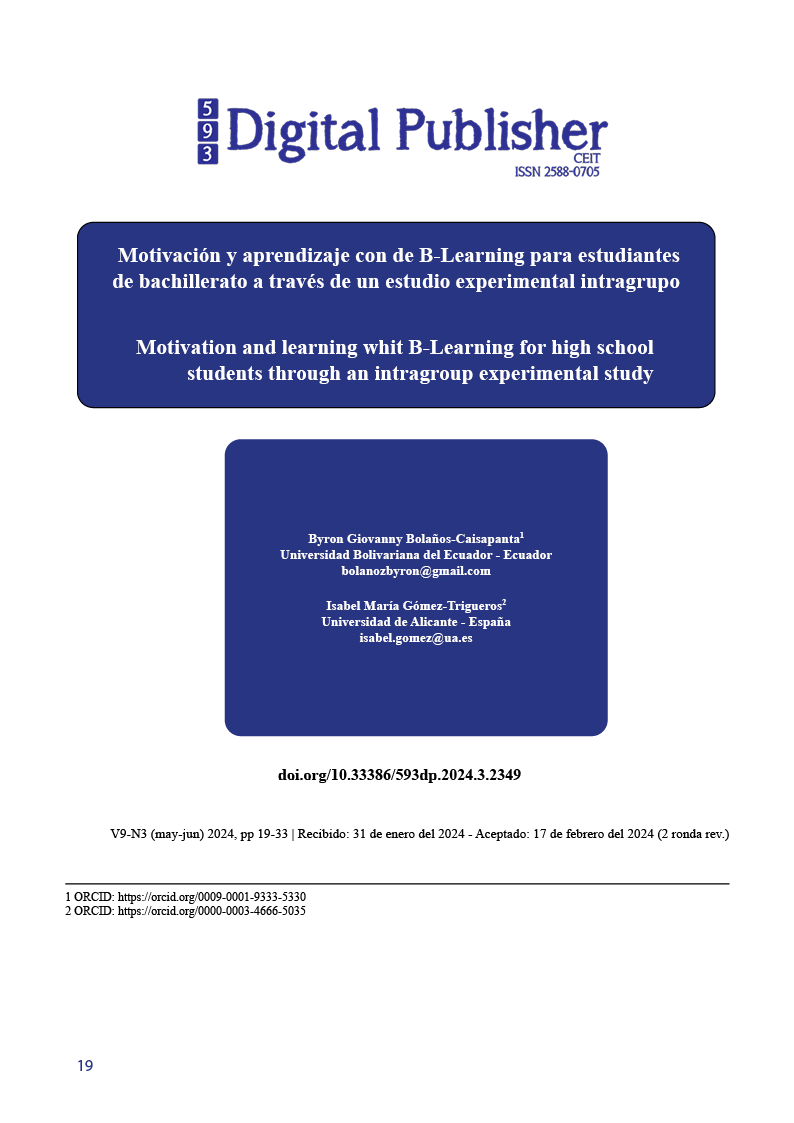Motivation and learning through B-Learning for high school students through an intragroup experimental study
Main Article Content
Abstract
This work analyzes the use of a virtual learning platform within the teaching-learning process as support for presence to verify the improvement of academic performance in Secondary students. Through a descriptive-participatory, quantitative methodology with two mixed questionnaires (pre and post) validated as research instruments, a diagnostic evaluation was carried out on a sample of 60 students in the biology subject of the third year of Baccalaureate. For this purpose, the questionnaire was distributed prior to the educational intervention with B-Learning; Subsequently, a virtual classroom was created within the Google Classroom platform, with disciplinary materials and interactive tasks for participating students to work on said content. Finally, the questionnaire was distributed again (post) to know the perception of the B-Learning resource after the intervention. The results show positive data about this type of resources and platforms in combination with face-to-face teaching. Furthermore, the motivating value of B-Learning and virtual classrooms for the teaching and learning of specific content and their capacity for the development of digital skills of 21st century citizens is confirmed.
Downloads
Article Details

This work is licensed under a Creative Commons Attribution-NonCommercial-ShareAlike 4.0 International License.
1. Derechos de autor
Las obras que se publican en 593 Digital Publisher CEIT están sujetas a los siguientes términos:
1.1. 593 Digital Publisher CEIT, conserva los derechos patrimoniales (copyright) de las obras publicadas, favorece y permite la reutilización de las mismas bajo la licencia Licencia Creative Commons 4.0 de Reconocimiento-NoComercial-CompartirIgual 4.0, por lo cual se pueden copiar, usar, difundir, transmitir y exponer públicamente, siempre que:
1.1.a. Se cite la autoría y fuente original de su publicación (revista, editorial, URL).
1.1.b. No se usen para fines comerciales u onerosos.
1.1.c. Se mencione la existencia y especificaciones de esta licencia de uso.
References
Aguilar, V. J. A., & Santana, M. Y. J. (2021). La metodología b-learning y el uso de los recursos didacticos virtuales para el proceso de enseñanza. Tesis Universidad Técnica de Machala Retrieved from http://repositorio.utmachala.edu.ec/bitstream/48000/18193/1/Trabajo_Titulacion_48.pdf
Al-Awlaqi, M. A., Barahma, M. M., Basrda, T. S. A., & AL-Tahitah, A. (2022). The effect of B-learning adoption on the evolution of self-regulation skills: a longitudinal study on a group of private universities’ freshman students. In International Conference on Information Systems and Intelligent Applications (pp. 279-290). Springer International Publishing.
Al-Tahitah, A.N., Al-Sharafi, M.A., & Abdulrab, M. (2021). How COVID-19 pandemic is accelerating the transformation of higher education institutes: a health belief model view. In: Arpaci I, Al-Emran M, Al-Sharafi MA, Marques G (eds) Emerging technologies during the era of COVID-19 pandemic. Studies in systems, decision and control (pp. 333-347). Springer, Cham. https://doi.org/10.1007/978-3-030-67716-9_21
Arias, O. M. (2010). Ambientes virtuales de aprendizaje b-learning y su incidencia en la motivación y estrategias de aprendizaje en Estudiantes de secundaria. Tecné, Episteme y Didaxis: TED, 27, 148-149.
Ariza, C. R. & Pons, B. L. (2021). Medios y redes sociales en la enseñanza-aprendizaje del inglés: valoraciones de estudiantes universitarios. REXE. Revista de Estudios y Experiencias en Educación, 20(43), 129-148. https://dx.doi.org/10.21703/rexe.20212043ariza7
Basogain, X., Angel, M., Carlos, J., & Javier, M. (2018). Computers in human behavior computational thinking in pre-university blended learning classrooms. Computational Thinking in Pre-University Blended Learning Classrooms, 80, 412-419. https://doi.org/10.1016/j.chb.2017.04.058
Bordoloi, R., Das, P., & Das, K. (2021). Perception towards online/blended learning at the time of Covid-19 pandemic: academic analytics in the Indian context. Asian Association of Open Universities Journal, 16(1), 41-60. https://doi.org/10.1108/AAOUJ-09-2020-0079
Da Silva, K. K. A., & Behar, P. A. (2017). Digital competence model of distance learning students. En International Association for Development of the Information Society (IADIS), International Conference on Cognition and Exploratory Learning in Digital Age (pp. 109-116), Algarve, Portugal, 18-20 de octubre. Retrieved from https://eric.ed.gov/?id=ED579459
Fearon C., Starr S., & McLaughlin H. (2011). Value of blended learning in university and the workplace: some experiences of university students. Industrial and Commercial Training 43(7), 446-450. https://doi.org/10.1108/00197851111171872
Fernandes, J., Costa, R., & Peres, P. (2016). Putting Order into Our Universe: The Concept of Blended Learning—A Methodology within the Concept-based Terminology Framework. Education Sciences, 6(2), 15. https://doi.org/10.3390/educsci6020015
García-González, L. A., & Solano-Suarez, A. (2020). Enseñanza de la Matemática mediada por la tecnología. EduSol, 20(70), 84-99. Retrieved from http://scielo.sld.cu/scielo.php?script=sci_arttext&pid=S1729-80912020000100084&lng=es&tlng=en
Autores (2023)
Ibáñez, F. (2020). Educación en línea, Virtual, a Distancia y Remota de Emergencia, ¿cuáles son sus características y diferencias? Instituto para el Futuro de la Educación. Tecnológico de Monterrey. Retrieved from https://observatorio.tec.mx/edu-news/diferencias-educacion-online-virtual-a-distancia-remota/
Järvelä, S., Malmberg, J., & Koivuniemi, M. (2016). Recognizing socially shared regulation by using the temporal sequences of online chat and logs in CSCL. Learning and Instruction, 42, 1-11. https://doi.org/10.1016/j.learninstruc.2015.10.006
Le, H. T. T., Nguyen, N. L. T., Nguyen, T. T., Nguyen, N. T., & Nguyen, H. T. T. (2022). Application of blended learning in teaching and learning at high schools in Vietnam. In Educational Innovation in Vietnam (pp. 206-222). Routledge.
Lohse, H., Kunina, O., & Kunter, M. (2013). The role of educational psychology in teacher education: expert opinions on what teachers should know about learning, development, and assessment. European Journal of Psychology of Education, 28(4), 1543-1565. Retrieved from https://www.jstor.org/stable/23580923
Mingorance, Á. C., Granda, J., Rojas, G., & Alemany, I. (2019). Flipped Classroom to Improve University Student Centered Learning and Academic Performance. Social Sciences, 8(11), 315. https://doi.org/10.3390/socsci8110315
Monguet, J., Fábregas, J., Delgado, D., Grimón, F., & Herrera, M. (2006). Efecto del blendend learning sobre el rendimiento y la motivación de los estudiantes. Interciencia, 31(3), 190-196.
Molina-Garzón, N. C., & Palma-Villavicencio, M. M. (2022). Metodologías activas en entornos virtuales: Propuesta didáctica para el desarrollo de competencias contables. Episteme Koinonia,5(1), 950-978. https://doi.org/10.35381/e.k.v5i1.2142
Orozco, C., Labrador, M., & Palencia, A. (2002). Metodología. Manual teórico práctico de metodología para tesistas, asesores, tutores y jurados de trabajos de investigación y ascenso. Ofimax de Venezuela.
Owen, H., & Dunham, N. (2015). Reflections on the Use of Iterative, Agile and Collaborative Approaches for Blended Flipped Learning Development. Education Sciences, 5(2), 85-103. https://doi.org/doi:10.3390/educsci5020085
Raykov, T., & Marcoulides, G. (2017). Evaluation of True Criterion Validity for Unidimensional Multicomponent Measuring Instruments in Longitudinal Studies. Structural Equation Modeling: A Multidisciplinary Journal, 24, 599-608. Retrieved from https://tinyurl.com/ysc25yc5
Ruiz, C. (2011). Tendencias actuales en el uso del B-Learning: Un análisis en el contexto del tercer congreso virtual Iberoamericano sobre la calidad en educación a distancia (EduQ@2010). Investigación y Postgrado, 26(1), 9-30. Retrieved from http://ve.scielo.org/scielo.php?script=sci_arttext&pid=S1316-00872011000100002&lng=es&tlng=es.
Sáiz, M. C., Marticorena, R., García, C. I., & Díez-Pastor, J. F. (2017). How do B-learning and learning patterns influence learning outcomes? Frontiers in Psychology, 8, 745. https://doi.org/10.3389/fpsyg.2017.00745
Salinas, I. J., de Benito C., B., Pérez, G. A. & Gisbert, C. M. (2018). Aprendizaje mixto, más allá de la clase presencial. Revista Iberoamericana de educación a distancia, 21(1),195-213. https://doi.org/http://dx.doi.org/10.5944/ried.21.1.18859
Strang, K. D. (2017). Beyond engagement analytics: which online mixed-data factors predict student learning outcomes? Education and Information Technologies, 22, 917-937. https://doi.org/10.1007/s10639-016-9464-2
Tomalá, M. A., Gallo, G. G., Mosquera, J. L., & Chancusig, J. C. (2020). Las plataformas virtuales para fomentar aprendizaje colaborativo en los estudiantes del bachillerato. Recimundo, 4(4), 199-212. Retrieved from https://recimundo.com/index.php/es/article/view/899/1622
Tunmibi, S., Aregbesola, A., Adejobi, P., & Ibrahim, O. (2015). Impact of E-Learning and Digitalization in Primary and Secondary Schools. Journal of education and practice, 6(17), 53-58. https://eric.ed.gov/?id=EJ1079751
Valverde-Berrococo, J., & Balladares B., J. (2017). Enfoque sociológico del uso del b-Learning en la educación digital del docente universitario. Sophia, 23, 123-140. https://doi.org/10.17163/soph.n23.2017.04
Wang, Y., Han, X., & Yang, J. (2015). Revisiting the blended learning literature: Using a complex adaptive systems framework. Educational Technology & Society, 18(2), 380-393. http://www.jstor.org/stable/jeductechsoci.18.2.380
Xinogalo, S. (2015). Object-oriented design and programming: an investigation of novices' conceptions on objects and classes. ACM Transactions on Computing Education, 15(3), 1-21. https://doi.org/10.1145/2700519
Yousef J.H., Alhourani M.I., & Al-Srehan H.S. (2022). Blended learning: the amount of requisite professional competencies in faculty members of Al Ain University from viewpoint of students. Journal of Applied Research in Higher Education, 14(4), 1433-1448. https://doi.org/10.1108/JARHE-06-2021-0206



